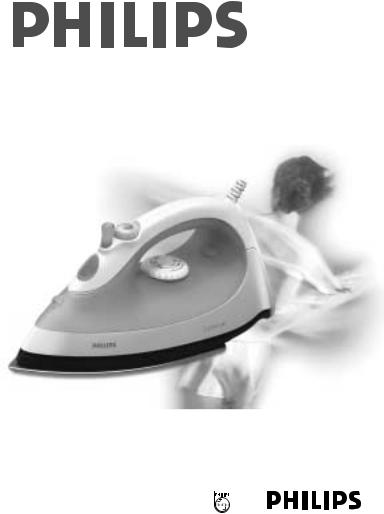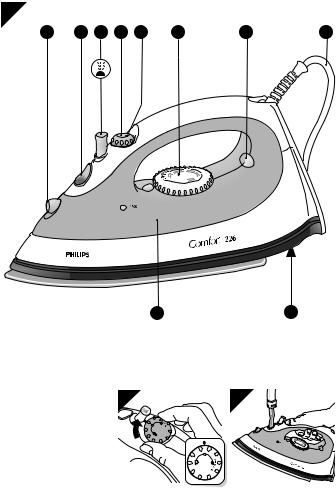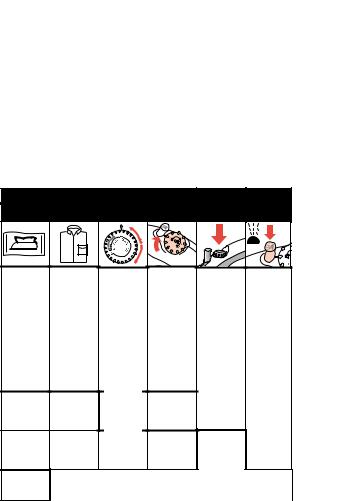Philips HI226/22, HI226/12, HI226/02, HI225/21, HI216/99 User Manual [es]
...
HI 204/205/206/215/216/225/226

English |
Page 4 |
•Keep page 3 and page 18 open when reading these operating instructions.
Español Página 11
• Desplegar las páginas 3 y 18 al leer las instrucciones de manejo.
2

1
D |
F C B J |
A |
E |
I |
G H
2 |
|
3 |
|
|
|
3

English
Important
•Read the instructions for use and look at the illustrations before you start using the steam iron.
•Remove any sticker or protective foil from the soleplate before you use the appliance for the first time. Clean the soleplate with a soft cloth.
•To prevent damage: check if the voltage indicated on the appliance corresponds to the local mains voltage before you connect the appliance.
•Use an earthed wall socket.
•Never use the appliance if it is damaged in any way.
•Unplug the appliance from the mains:
-before filling the iron with water or pouring out the remaining water after use.
-before cleaning the iron.
•When you have finished ironing and also when you leave the iron for a short while, always:
-set the steam control to position O;
-put the iron on its heel;
-remove the mains plug from the wall socket.
•Do not put vinegar, starch, chemically descaled water or descaling agents in the water reservoir.
•Make sure the cord does not touch the soleplate when it is hot.
•The ejected steam is hot and therefore dangerous. Never direct the steam at people.
•Always store the iron by placing it on its heel in a safe and dry place.
•Never immerse the iron in water.
•Some parts of the iron have been slightly greased and, as a result, the iron may give off some smoke when it is switched on for the first time. This phenomenon is harmless and will soon cease.
•This appliance is not intended for use by young or infirm persons without supervision.
•Young children should be supervised to ensure that they do not play with the appliance.
4

•If the mains cord of this appliance is damaged, it may only be replaced by a special cord assembly available from the manufacturer or its service agent.
General description (fig. 1)
A Temperature control dial
BSteam control dial O = no steam q = steam
w = maximum steam 1 = self-clean
C Spray button T (type HI 215/216/225/226)
D Spray nozzle (type HI 215/216/225/226)
E Temperature pilot light (amber)
F Water filling opening
G Water reservoir
H Type plate
I Cord
J Extra steam 0 (press) (type HI 225/226)
Ironing temperature guide
•Follow the ironing instructions on the garment label. If these instructions are missing but you do know the kind of fabric, consult the table.
•This table is only valid for plain fabrics and not for materials to which finishes, glosses etc. have been applied. Textile to which some kind of finish has been applied (gloss, crinkle, relief etc.) is best ironed at lower temperatures.
•First sort the laundry according to ironing temperature: put wool with wool, cotton with cotton, etc.
•The iron heats up more quickly than it cools down. Therefore, start ironing articles that need to be ironed at the lowest temperature, such as those made of synthetic fibres.
•If the fabric consists of various kinds of fibres, always select the temperature required by the most delicate fibre, i.e. the lowest temperature. If, for example, an article consists of 60% polyester and 40% cotton, it should be ironed at the temperature indicated for polyester
(1) and without steam.
5

•If you do not know what kind(s) of fabric(s) the article is made of, find out the appropriate temperature by ironing a piece of material that will not be visible when you wear or use the article and start ironing at a relatively low temperature.
•Pure woollen fabrics (100% wool) may be pressed with the iron set to a steam position. It is advisable to set the steam control (B) to maximum position and to use a dry pressing cloth.
•When steam-ironing woollen fabrics, shiny patches may occur. You can prevent this by turning the article inside out and ironing the reverse side.
•Velvet and other fabrics which tend to acquire shiny spots should be ironed in one direction only (along with the nap) while applying very little pressure.
Always keep the appliance moving while ironing.
Fabric table
Instructions |
Fabric |
Temperature |
Steam |
Extra |
Spray |
on label |
|
control |
control |
Steam |
|
|
Synthetic |
MIN |
|
|
|
|
A |
|
|
|
|
|
fibres, e.g. |
A |
|
|
|
|
acryl, |
|
|
|
|
|
1 |
|
|
|
|
|
viscose, |
|
|
|
|
B |
polyamide |
A |
|
|
|
(nylon), |
A |
|
Extra |
|
|
|
polyester |
A |
|
|
|
|
|
O |
0 |
|
|
|
|
A |
T |
||
|
Silk |
A |
|
X |
|
|
|
A |
|
|
|
|
|
2 |
|
|
|
C |
Wool |
A |
q |
|
|
A |
|
|
|||
|
|
|
|
||
|
|
3 |
|
Extra |
|
|
CottonLinen |
MAX |
|
|
|
D |
w |
0 |
|
Please note that Z on the label means:
Z“This article cannot be ironed!”
6
